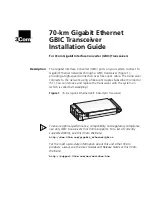
–
–
–
–
18
19
Transceiver Operation
The transceiver has two modes of operation: Initiating Unit (IU) that
transmits control messages and Responding Unit (RU) that receives control
messages. If all of the status lines are set as inputs, then the module is set
as an IU only. The module stays in a low power sleep mode until a status
line goes high, starting the Transmit Operation.
If all of the status lines are set as outputs, then the module is set as an RU
only. It stays in Receive Operation looking for a valid transmission from a
paired IU.
A module with both input and output status lines can operate as an IU
and an RU. The module idles in Receive Operation until either a valid
transmission is received or a status line input goes high, initiating the
Transmit operation.
When an input goes high, the transceiver captures the logic state of each
of the status lines. The line states are placed into a packet along with the
local 32-bit address. The IU transmits the packets as it hops among 25 RF
channels.
An RU receives the packet and checks its Paired Module List to see if the
IU has been paired with the module and is authorized to control it. If the
IU’s address is not in the table, then the RU ignores the transmission. If
the address is in the table, then the RU calculates the channel hopping
pattern from the IU’s address and sets its status line outputs according to
the received packet. It then hops along with the IU and updates the states
of its outputs with every packet. Its outputs can be connected to external
circuitry that activates when the lines go high.
The RU can also send an acknowledgement back to the IU. Using the
serial interface the RU can include up to two bytes of custom data with
the acknowledgement, such as sensor data or battery voltage levels.
Using the hardware control, if ACK_EN is high when a valid control packet
is received, the module sends back a simple acknowledgement (ACK). It
sends an Acknowledge with Data (AWD) response when custom data is
programmed into the module using a serial command.
Transmit Operation
Transmit Operation is entered when any of the status line inputs go high.
During Transmit Operation, the MODE_IND line is high. The module
repeatedly transmits control messages containing the local address and
the state of all status lines. Between transmissions the module listens for
acknowledgement messages. If an Acknowledge (ACK) or Acknowledge
with Data (AWD) message is received for the transmitted data, the
ACK_OUT line is asserted for 100ms. The ACK_OUT timing restarts on
each ACK or AWD packet that is received.
The transceiver sends control messages every 12.5ms as long as any
of the status line inputs is high, updating the status line states with
each packet. When all input lines are low, the module starts the shutoff
sequence.
During the shutoff sequence, the transmitter sends at least one packet with
all outputs off. It then continues to transmit data until the current channel
hopping cycle is complete, resulting in balanced channel use. If an input
line is asserted during the shutoff sequence, the transmitter cancels the
shutoff and extends the transmission sequence.
Receive Operation
During Receive Operation, the module waits for a valid control message
from an authorized (paired) transceiver. When a valid message is received,
it locks onto the hopping pattern of the transmitter and asserts the MODE_
IND line. It compares the received status line states to the Permission Mask
for the IU to see if the IU is authorized to activate the lines. The module sets
all authorized outputs to match the received states.
Only status line outputs are affected by received control packets. Received
commands to change an input line have no effect.
The RU then checks the state of the ACK_EN line and transmits an
acknowledgement packet if it is high. It looks for the next valid packet while
maintaining the frequency hopping timing. As long as an RU is receiving
valid commands from a paired IU, it will not respond to any other unit.
Once eight consecutive packets are missed, the RU is logically
disconnected from the IU and waits for the next valid packet from any IU.













































